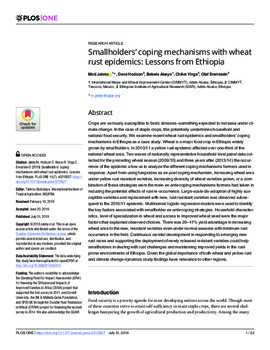Mostrar el registro sencillo del ítem
Smallholders’ coping mechanisms with wheat rust epidemics: lessons from Ethiopia
| Autor: | Debello, M.J. |
| Autor: | Hodson, D.P. |
| Autor: | Abeyo Bekele Geleta |
| Autor: | Yirga, C. |
| Autor: | Erenstein, O. |
| Año: | 2019 |
| ISSN: | 1932-6203 (Online) |
| URI: | https://hdl.handle.net/10883/20540 |
| Resumen: | Crops are variously susceptible to biotic stresses–something expected to increase under climate change. In the case of staple crops, this potentially undermines household and national food security. We examine recent wheat rust epidemics and smallholders’ coping mechanisms in Ethiopia as a case study. Wheat is a major food crop in Ethiopia widely grown by smallholders. In 2010/11 a yellow rust epidemic affected over one-third of the national wheat area. Two waves of nationally representative household level panel data collected for the preceding wheat season (2009/10) and three years after (2013/14) the occurrence of the epidemic allow us to analyze the different coping mechanisms farmers used in response. Apart from using fungicides as ex-post coping mechanism, increasing wheat area under yellow rust resistant varieties, increasing diversity of wheat varieties grown, or a combination of these strategies were the main ex-ante coping mechanisms farmers had taken in reducing the potential effects of rust re-occurrence. Large-scale dis-adoption of highly susceptible varieties and replacement with new, rust resistant varieties was observed subsequent to the 2010/11 epidemic. Multinomial logistic regression models were used to identify the key factors associated with smallholder ex-ante coping strategies. Household characteristics, level of specialization in wheat and access to improved wheat seed were the major factors that explained observed choices. There was 29–41% yield advantage in increasing wheat area to the new, resistant varieties even under normal seasons with minimum rust occurrence in the field. Continuous varietal development in responding to emerging new rust races and supporting the deployment of newly released resistant varieties could help smallholders in dealing with rust challenges and maintaining improved yields in the rustprone environments of Ethiopia. Given the global importance of both wheat and yellow rust and climate change dynamics study findings have relevance to other regions. |
| Formato: | |
| Lenguaje: | English |
| Editor: | Public Library of Science |
| Copyright: | CIMMYT manages Intellectual Assets as International Public Goods. The user is free to download, print, store and share this work. In case you want to translate or create any other derivative work and share or distribute such translation/derivative work, please contact CIMMYT-Knowledge-Center@cgiar.org indicating the work you want to use and the kind of use you intend; CIMMYT will contact you with the suitable license for that purpose. |
| Tipo: | Article |
| Lugar de publicación: | San Francisco, CA (USA) |
| Páginas: | art. e0219327 |
| Número: | 7 |
| Volumen: | 14 |
| DOI: | 10.1371/journal.pone.0219327 |
| País: | ETHIOPIA |
| Agrovoc: | SMALLHOLDERS |
| Agrovoc: | RUSTS |
| Agrovoc: | WHEAT |
| Datasets relacionados: | http://doi.org/10.3886/E110562V1 |
| Revista: | PLoS ONE |
Ficheros en el ítem
Este ítem aparece en la(s) siguiente(s) colección(ones)
-
Socioeconomics
Including topics such as farming systems, markets, impact & targeting, innovations, and GIS -
Wheat
Wheat - breeding, phytopathology, physiology, quality, biotech

